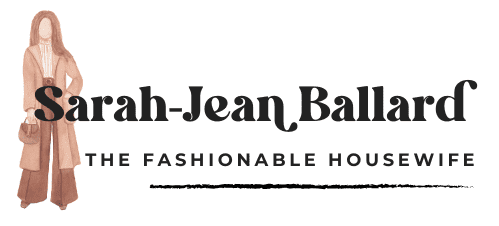Maintaining Your Castle: Pro Advice on Landscaping, Plumbing, and HVAC

Mastering Your Domain With Essential Home Services with Year-Round Landscaping and Outdoor Care
Your home is a valuable asset. It’s where memories are made and futures are built. Protecting this investment requires consistent care and attention.
We often think of home maintenance as just fixing things when they break. But a proactive approach saves money and stress in the long run.
This guide will walk you through the key areas of home upkeep. We’ll cover landscaping, plumbing, and HVAC systems. Our goal is to empower you with expert advice.
By understanding these essential home services, you can ensure your home remains comfortable, safe, and retains its value for years to come.
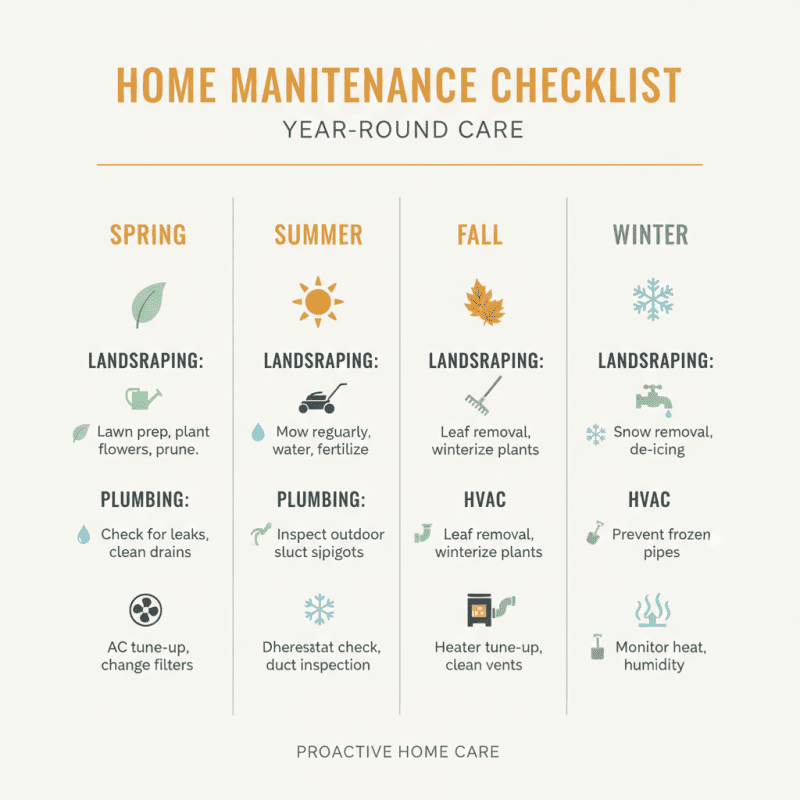
A well-maintained landscape does more than enhance curb appeal; it significantly contributes to your home’s structural integrity and overall value. From the vibrant hues of spring flowers to the crisp lines of a winter-ready yard, seasonal landscaping is a continuous cycle of care and preparation.
Our approach to outdoor care emphasizes proactive measures. This includes regular lawn maintenance, ensuring your grass is healthy and weed-free, which prevents erosion and supports the surrounding ecosystem. Pruning trees and shrubs isn’t just about aesthetics; it’s crucial for plant health, promoting growth, and removing dead or diseased branches that could pose a hazard during storms. Furthermore, proper pruning ensures that vegetation doesn’t encroach on your home’s structure, preventing potential damage to roofs or siding.
Gutter cleaning, often overlooked, is a vital component of outdoor maintenance. Clogged gutters can lead to water overflow, causing damage to your home’s foundation, siding, and fascia. Especially before winter, keeping gutters clear is essential to prevent ice dams, which can cause significant roof damage and interior leaks. By staying on top of these tasks, we ensure your home’s exterior is not only beautiful but also resilient against the elements.

Why Seasonal Landscaping is an Essential Home Service
As the seasons turn, the demands on our outdoor spaces evolve, with winter presenting some of the most significant challenges. Preparing your property for colder months is not merely about aesthetics; it’s about safety, preservation, and adhering to community standards. Snow removal, in particular, transforms from a chore into a critical responsibility for individuals, municipalities, and contractors alike.
Effective snow removal is a multifaceted process, encompassing a range of equipment, strategies, and considerations. For homeowners, it often begins with manual shoveling, a physically demanding task that, while effective for small areas, carries health risks, especially for those with cardiovascular conditions. Injuries related to snow shoveling are unfortunately common, highlighting the need for proper technique and, for some, alternative methods. Of snow removal
Types of Snow Removal Equipment:
- Manual Shovels: Inexpensive and good for small areas. Pros: Low cost, good exercise. Cons: Physically demanding, time-consuming, risk of injury.
- Snow Blowers: Ideal for medium to large driveways and walkways.
- Single-Stage: Best for light, fluffy snow (up to 8-12 inches). Pros: Lighter, easier to maneuver, generally less expensive. Cons: The auger touches the ground (not ideal for gravel), is less powerful, and cannot handle heavy, wet snow.
- Two-Stage: Handles heavy, wet snow and deeper drifts (up to 2 feet). Pros: More powerful, auger doesn’t touch the ground (safe for gravel), throws snow further. Cons: Heavier, more expensive, requires more storage.
- Three-Stage: Most powerful, designed for icy conditions and very deep snow. Pros: Breaks up ice, highly efficient for extreme conditions—cons: Heaviest, most expensive.
- Snowplows (Truck/Tractor-Mounted): Primarily used for large areas, such as driveways, parking lots, and roads. Pros: Very fast for large volumes of snow. Cons: Requires a suitable vehicle, a significant investment, and can damage surfaces if not operated with care.
- Skid-Steer Loaders/Front-End Loaders: Versatile machines with various attachments (buckets, snow pushers, blowers) for commercial and municipal use. Pros: High capacity, efficient for moving and piling snow. Cons: Expensive, requires skilled operators.
- Specialized Equipment: Snow melters (for high-density urban areas), snow vacuums, and winter service vehicles (including gritters).
Responsibilities in Snow Removal:
- Individuals: Often responsible for clearing sidewalks adjacent to their property and their own driveways. Regulations vary by municipality, with some (like Willingboro Township) imposing fines for non-compliance within a set timeframe (e.g., 24 hours after snowfall ends).
- Municipalities: Tasked with clearing public roads, highways, and critical infrastructure. They prioritize emergency routes, arterial roads, and then residential streets. This involves significant planning, resource allocation (e.g., Mercer County Highway Division has 6,000 tons of salt ready), and a fleet of specialized vehicles.
- Contractors: Offer services to individuals and businesses, using various equipment to clear private properties. Their contracts can range from per-event to full-season agreements.
Best Practices for Effective and Safe Snow Removal:
- Plan Ahead: Monitor weather forecasts and have equipment and supplies ready.
- Clear Early and Often: It’s easier to remove fresh, lighter snow than compacted, icy layers.
- Use Proper Technique: When shoveling, push the snow rather than lifting it, or lift with your legs, not your back. Take frequent breaks.
- Stay Hydrated: Even in cold weather, physical exertion requires hydration.
- Dress Appropriately: Layers, waterproof outer gear, gloves, and warm footwear are essential.
- Mark Obstacles: Use snow poles or stakes to mark curbs, fire hydrants, and delicate landscaping to prevent damage from plows or blowers.
- Avoid Piling Snow in Hazardous Areas: Don’t create large snowbanks that block visibility at intersections or accumulate on drainage systems.
- Clear a Full Path: Ensure sidewalks and access points are wide enough for safe passage. Businesses, in particular, must clear accessible parking spaces and access ramps within specific timeframes.
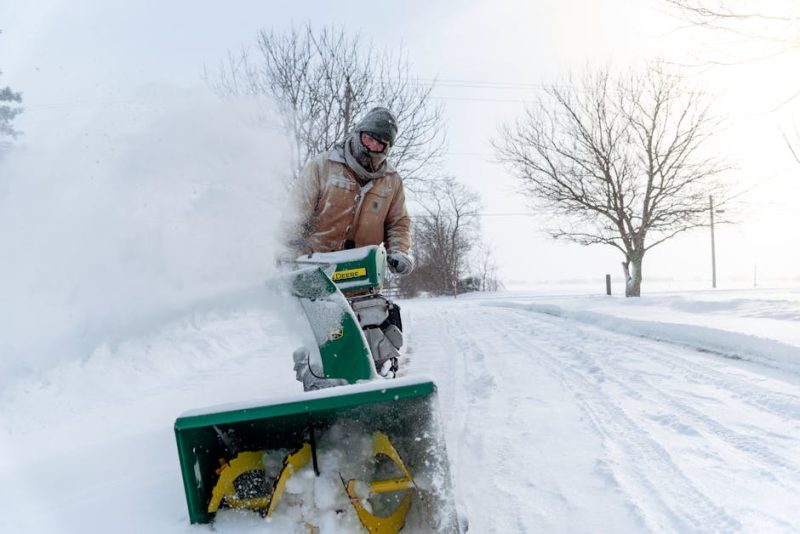
Environmental Impacts of De-icing Agents:
While crucial for safety, de-icing agents, particularly rock salt (sodium chloride), have significant environmental drawbacks. Salt can corrode infrastructure, damage vehicles, and harm vegetation. When it melts into waterways, it can increase salinity, impacting aquatic life and drinking water sources. Alternatives like calcium chloride and magnesium chloride are effective at lower temperatures but are more expensive and can still be corrosive. Newer, more environmentally friendly options include organic compounds derived from agricultural byproducts (like beet juice or cheese brine), which reduce the amount of traditional salt needed. However, these also have their own considerations, such as potential oxygen depletion in water bodies if used excessively.
Managing these tasks is a key part of maintaining your property and ensuring public safety, making snow removal an essential component of comprehensive essential outdoor home services.
Regional Strategies and Regulations:
Snow removal strategies vary widely depending on climate, population density, and budget. Cities like Montreal, which experience heavy snowfall, spend over $158 million annually, often requiring snow hauling to designated dump sites. In contrast, Toronto, with a larger population but less snowfall, spends about half of Montreal’s budget. Regulations also differ; some municipalities require property owners to clear sidewalks within 24-48 hours, while others assume more responsibility for public walkways. These regional differences highlight the importance of local awareness and compliance with specific ordinances.
Costs Associated with Snow Removal:
Costs can range from the purchase of a $20 shovel to multi-million dollar municipal budgets. For homeowners, a snow blower can cost anywhere from a few hundred to several thousand dollars. Professional services can be priced per visit, per inch of snow, or as a seasonal contract, with prices varying significantly based on property size, location, and desired service level. For example, forum discussions reveal seasonal agreements ranging from $650 to over $ 1300 for residential driveways, with some users expressing frustration over rising costs and unreliable service.

Technological Advancements and Innovations:
Innovations include advanced weather forecasting models, GPS-enabled plow trucks for optimized routing, and more efficient de-icing application systems. Heated pavement systems, while costly, offer a permanent solution for critical areas. Autonomous snow removal vehicles are also in development, promising increased efficiency and reduced labor costs in the future.
Safety Considerations:
Safety is paramount. For those performing snow removal, this includes proper training, wearing high-visibility clothing, and being aware of surroundings. For the public, this means understanding municipal plowing routes, avoiding parking on streets during snow emergencies, and exercising caution around snow removal equipment. The danger of flying ice from vehicles (the “snow missile” effect) is a serious concern, emphasizing the need for drivers to clear their cars completely.
Impact on Urban Infrastructure and Planning:
Snow removal significantly influences urban design. Wider boulevards are often needed to accommodate snowbanks. Sidewalks are sometimes placed further from roads to protect pedestrians from splashback and plows. Embedded lane markers, resistant to plow damage, are preferred over raised ones. Snow dump sites, like those used in Helsinki for millions of cubic meters of snow, require careful planning to prevent environmental contamination.
Common Challenges and Complaints:
Common complaints include unreliable service from contractors, damage to private property (such as mailboxes and landscaping) by municipal plows, the formation of windrows (snow piled at the end of driveways by plows), and the environmental impact of salt. Residents often express frustration with the timing of plowing, especially when streets are cleared after private driveways or when services fail to arrive promptly.
The Heartbeat of Your Home: Essential Plumbing Services
Just as landscaping protects your home’s exterior, a robust plumbing system is vital for its interior health and functionality. Plumbing is often out of sight, out of mind, until a problem arises. However, proactive maintenance can prevent costly and disruptive emergencies.
Our focus on plumbing maintenance begins with preventative measures. Regularly checking for leaks, even small drips, can save gallons of water and prevent hidden damage to walls, floors, and foundations. We advocate for understanding your home’s water pressure; excessively high pressure can strain pipes and appliances, leading to premature wear and tear.
Drain cleaning is another critical aspect. Slow drains are often a precursor to complete blockages, which can cause backups and potential water damage. Simple habits, such as avoiding the practice of pouring grease down the drain and using drain screens, can go a long way. For more stubborn clogs, professional snaking or hydro-jetting may be necessary to clear the lines effectively.
Water heater maintenance is also crucial. Flushing your water heater annually helps remove sediment buildup, which can reduce efficiency and shorten the unit’s lifespan. Regular inspections can identify potential issues, such as leaks or corrosion, before they escalate into a cold shower emergency. By prioritizing these foundational plumbing tasks, we ensure your home’s water systems run smoothly and efficiently.
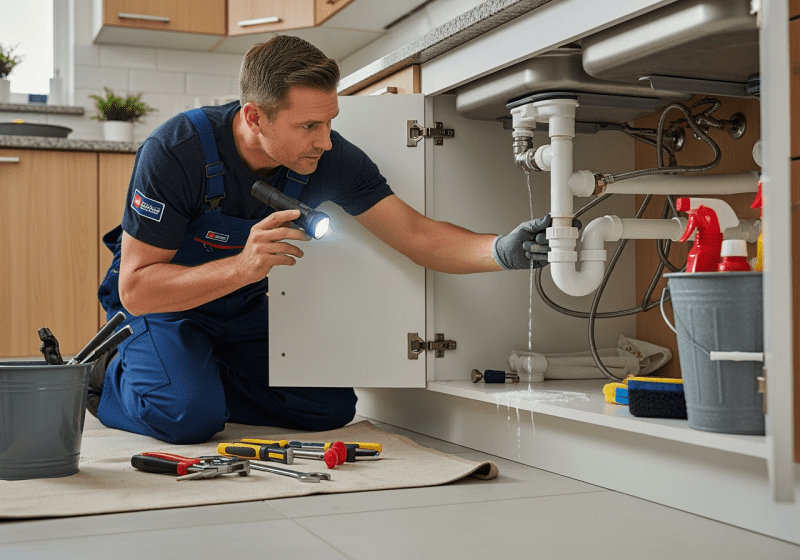
Addressing Major Plumbing Concerns
While routine maintenance can prevent many issues, some plumbing problems signal a more serious underlying condition, particularly with your main water line. This critical component delivers water from the municipal supply to your home, and issues here can affect your entire property.
Signs of a main water line problem are often unmistakable and demand immediate attention. If you notice persistent soggy spots or unusually lush patches in your yard, especially when there hasn’t been recent rain, it could indicate an underground leak in the main line. A sudden and unexplained drop in water pressure throughout your home, affecting multiple fixtures, is another strong indicator. Discolored water, particularly with brownish or rusty hues, can also indicate corrosion within the main line or issues with the municipal supply connection.
These symptoms should never be ignored. A compromised main water line can lead to significant water waste, structural damage to your property, and even contamination of your drinking water. The complexity and potential severity of these issues underscore the importance of professional diagnosis. Attempting DIY repairs on a main water line can exacerbate the problem, leading to more extensive damage and higher repair costs. Knowing when to seek professional assistance for a major issue like this is paramount. For comprehensive information and guidance on such critical repairs, understanding what constitutes trusted water line repair can prevent costly property damage and ensure your home’s water supply remains secure.
Ensuring Comfort and Air Quality: A Guide to HVAC Essentials
Your home’s HVAC (Heating, Ventilation, and Air Conditioning) system is the silent workhorse that keeps your indoor environment comfortable year-round, regardless of external temperatures. Beyond comfort, it plays a crucial role in maintaining indoor air quality, which has a direct impact on your family’s health.
Our expertise highlights the importance of system efficiency. An HVAC system running optimally consumes less energy, resulting in lower utility bills and a smaller carbon footprint. A simple yet highly effective way to maintain this efficiency is through regular filter changes. A clogged filter restricts airflow, forcing your system to work harder, which not only wastes energy but also reduces its lifespan. We recommend checking filters monthly and replacing them every 1-3 months, depending on usage and household factors like pets or allergies.
Improving indoor air quality is another key benefit of a well-maintained HVAC system. Beyond filtration, ensuring proper ventilation prevents the buildup of pollutants, allergens, and stale air. Annual professional servicing is non-negotiable. During these check-ups, technicians can identify potential issues, clean coils, verify refrigerant levels, and ensure that all components are functioning properly. This preventative care extends the life of your unit and maintains peak performance.
Ultimately, thermostat optimization enables you to control your home’s climate effectively. Programmable or smart thermostats allow you to set schedules that align with your family’s routine, ensuring comfort when you’re home and energy savings when you’re away. By understanding and implementing these HVAC essentials, you can create a healthier, more comfortable, and energy-efficient living space.
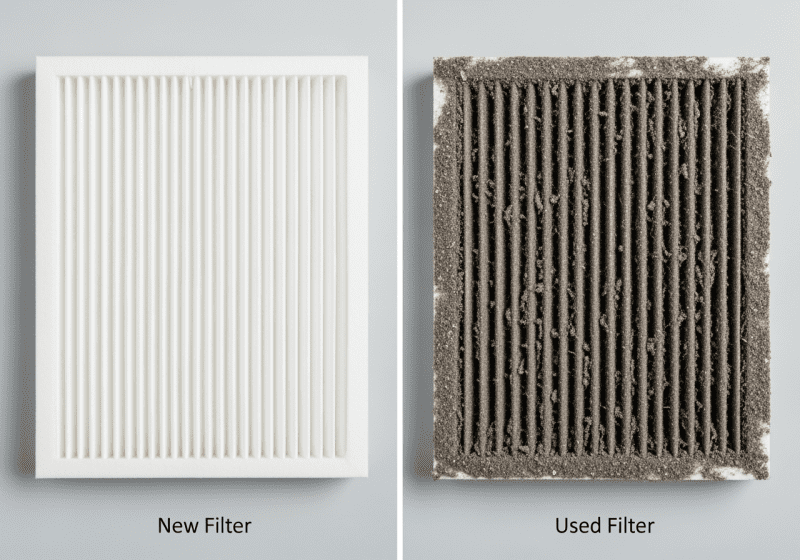
Planning for HVAC Repairs and Replacements
Even with diligent maintenance, HVAC systems have a finite lifespan. Understanding when to repair and when to replace is a crucial aspect of homeownership. The average lifespan of a furnace is typically 15 to 20 years, while air conditioners last approximately 10 to 15 years. As units approach or exceed these age ranges, they become more prone to breakdowns and inefficiency.
Warning signs of impending HVAC failure are often subtle at first but become more pronounced over time. Inconsistent temperatures throughout your home, where some rooms are too hot while others are too cold, indicate that your system is struggling to distribute air effectively. Strange noises, such as grinding, squealing, or banging, are red flags that internal components are failing. A noticeable and steady rise in your energy bills, without a corresponding increase in usage, is a clear sign that your system is losing efficiency and working harder to achieve desired temperatures.
The cost of major repairs or a complete system replacement can be substantial and often unexpected. While minor repairs might be a cost-effective solution for a newer unit, investing heavily in an aging system that frequently breaks down can be a financial drain. At a certain point, the cumulative repair costs and the inefficiency of an old unit outweigh the investment in a new, more efficient model. When faced with such significant expenses, exploring options like We Fix It Home Services financing can make unexpected replacements more manageable, ensuring your home remains comfortable without undue financial strain.
Creating a Proactive Plan for Your Essential Home Services
Effective home maintenance isn’t about reacting to problems; it’s about anticipating and preventing them. Creating a proactive plan for your essential home services is the cornerstone of responsible homeownership, ensuring peace of mind and protecting your investment.
We recommend starting with a comprehensive maintenance calendar. This calendar should outline seasonal tasks for landscaping (spring clean-up, fall leaf removal, winter snow preparedness), regular plumbing checks (leak detection, drain maintenance, water heater flushing), and HVAC servicing (filter changes, annual professional tune-ups for heating and cooling). By scheduling these tasks in advance, you ensure nothing is overlooked and can better allocate your time and resources.
Vetting professional contractors is another critical step. Not all service providers are created equal, and entrusting your home to qualified hands is paramount. Always verify proper licensing and insurance; this protects you from liability in the event of accidents or subpar work. Reading reviews and seeking recommendations from trusted sources can offer valuable insights into a contractor’s reliability, professionalism, and work quality. Look for patterns in both positive and negative feedback to form a balanced view.
Furthermore, consider the benefits of service agreements or maintenance plans offered by reputable companies. These agreements often include priority scheduling, discounts on repairs, and regular preventative maintenance visits, which can save you money and headaches in the long run. By systematically planning and selecting your service providers, we help you build a network of trusted professionals who contribute to the enduring health of your home.
Budgeting for Essential Home Services
One of the most common pitfalls in homeownership is underestimating the financial commitment required for maintenance. Effective budgeting for essential home services involves both foresight and flexibility.
We advise setting aside funds specifically for routine maintenance. This can be a monthly allocation into a dedicated savings account or a larger annual sum earmarked for scheduled services, such as HVAC tune-ups, gutter cleaning, or tree pruning. Understanding the average cost ranges for common service calls can help you plan. For instance, a basic HVAC tune-up might range from $75 to $200, while a professional drain cleaning could cost $150 to $300. Major services, such as new water heater installation, can cost $800-$2000+, and significant landscaping projects may be even higher.
Creating an emergency fund for unexpected repairs is equally crucial. Plumbing leaks, HVAC breakdowns, or storm damage don’t adhere to a schedule and can quickly deplete savings if you’re unprepared. A good rule of thumb is to set aside 1-3% of your home’s value annually for maintenance and repairs, with a portion of that dedicated to emergencies.
Understanding the long-term return on investment (ROI) of these expenditures is key. While maintenance costs might seem like an outflow, they are, in fact, investments that prevent far more expensive problems down the line. A well-maintained home retains its value, operates more efficiently, and provides a safer, more comfortable living environment. Neglecting maintenance, conversely, often leads to accelerated depreciation, higher utility bills, and the potential for catastrophic failures.
Average Cost Ranges for Common Service Calls (Estimates):
- HVAC Tune-up (per unit): $75 – $200
- Drain Cleaning (basic): $150 – $300
- Water Heater Flush: $100 – $200
- Gutter Cleaning: $100 – $250 (depending on home size)
- Lawn Mowing (per visit): $40 – $70
- Tree Pruning (small tree): $150 – $500
- Pest Control (initial visit): $100 – $300
- Roof Inspection: $100 – $400
- Appliance Repair (minor): $100 – $400
- Emergency Plumbing Call: $200 – $500+ (before repairs)
Frequently Asked Questions about Essential Home Services
How often should I have my HVAC system professionally serviced?
We generally recommend annual professional servicing for your HVAC system. Ideally, this means one check-up in the spring for your air conditioning unit and another in the fall for your heating system. This bi-annual approach ensures that each component is inspected and tuned for optimal performance during its peak operating season. Regular servicing maximizes efficiency, extends the lifespan of your unit, and helps prevent unexpected breakdowns, ultimately saving you money on energy bills and costly repairs.
What are the most common signs of a hidden water leak?
Hidden water leaks can cause significant damage if left undetected. We advise homeowners to look out for several key indicators: an unexplained increase in their water bills without a change in usage, the sound of running water when no faucets are on, musty odors emanating from walls or floors, the appearance of mold or mildew, or damp spots on ceilings, walls, or flooring. Any of these signs warrants prompt investigation by a professional plumber.
What’s more important for winter safety: plowing snow or using de-icers?
For comprehensive winter safety, a combined approach of both plowing (or shoveling/blowing) snow and using de-icers is best. Plowing or mechanical removal is crucial for bulk snow removal, clearing pathways, driveways, and roads to make them passable. De-icers, on the other hand, are essential for preventing ice formation and melting residual snow and ice that mechanical removal can’t tackle. For walkways, de-icers provide critical traction and prevent the formation of dangerous black ice. For driveways and roads, de-icers ensure the surface remains clear and safe after plowing. Each method serves a distinct, vital role in maintaining winter safety.
Conclusion: Protecting Your Investment With Essential Home Services
Maintaining your home is an ongoing journey, but one that yields immense rewards. As we’ve explored, the interconnectedness of landscaping, plumbing, and HVAC care forms the foundation of a healthy, valuable property. From the critical task of snow removal that keeps your outdoor spaces safe and accessible, to the unseen network of pipes ensuring clean water flows freely, and the sophisticated systems that regulate your indoor climate, each element plays a vital role.
By adopting a proactive approach to home maintenance, you can move beyond reactive repairs. This foresight translates into significant savings, improved comfort, and, most importantly, the enduring protection of your most cherished asset. The peace of mind that comes from knowing your home is well-cared for is invaluable. Invest in your home’s health today, and it will continue to provide comfort, security, and value for generations to come.
